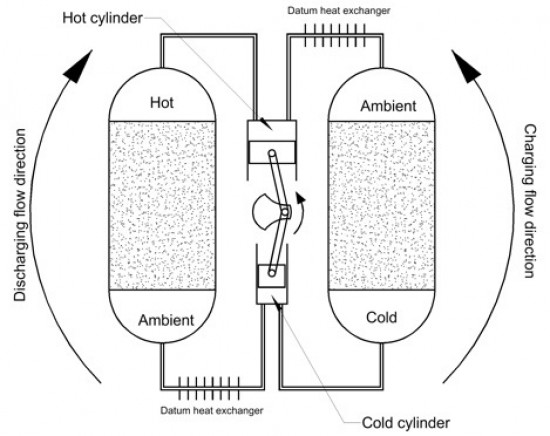Give the Isentropic PR department credit – they knew the magic words to say: “(I)t offers the prospect of being the lowest cost solution to the intermittency problems of renewable energy sources, such as wind.”
This is what everyone wants, the answer to so many of the criticisms of renewable energy. We’re talking utility-scale energy storage that might be economical and versatile enough to radically enhance the value of wind power. How? To put it in the simplest terms, Isentropic says it pulls this off by turning electricity into a temperature difference, then regenerating most of the electricity — from 72 to 80 percent — from the temperature difference.

Start by using electricity to pump heat from one gravel-filled vessel to another, with argon gas compressed at different levels to cool one container to -160 degrees Celsius and heat the other to 500 C.
Then: “The specially designed heat pump machine can be thermodynamically reversed to operate as an engine and the electricity is recovered by passing the heat from the hot container back through the machine to the cold container, while the machine drives an electrical generator,” Isentropic says.
Whether this is pie-in-the-sky hokum or something that might really work is something we’ll get a better idea of thanks to a tranche of new cash that will help Isentropic develop and deploy a 1.5-MW/6-MWh electricity storage unit on a U.K. primary substation in the Midlands region.
The money for what is being a Pumped Heat Electricity Storage project comes from the Energy Technologies Institute (ETI), in the form of project funding and an equity investment totaling £14m ($22m).

The ETI is a public-private partnership backed by the U.K. government and a half-dozen international energy and energy technology companies. It’s commissioned 36 renewable and low carbon projects worth £138 million but, it noted, this is the first time it has made an equity investment in any of the companies it has funded.
The most common large-scale storage system for renewables is pumped hydro, in which power is used to move water uphill, where it is stored in a reservoir, then released to create power when the power is desired. The advantage with the Isentropic system would be lower cost — less than pumped hydro’s $35/megawatt-hour, Isentropic says — along with much greater geographical versatility. That’s an advantage Isentropic’s system also has over compressed air, a large-scale storage technology that’s been around for a long time, but has only been used a couple of times.